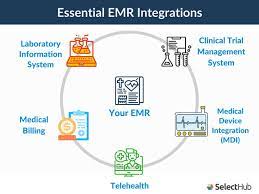The successful integration of Electronic Medical Records (EMR) software in healthcare practice can significantly enhance the quality of patient care. By following these tips, medical practices can maximize the benefits of integrated EMR software.
Define Clear Objectives
Before diving into the world of integrated EMR software, it’s crucial to establish clear objectives. What specific goals do you want to achieve with the integration? Whether it’s improving patient care, enhancing administrative efficiency, or ensuring data accuracy, clearly defined objectives will guide your implementation strategy.
Engage Stakeholders
Involving all relevant stakeholders is a key component of successful EMR integration. This includes healthcare providers, administrative staff, IT personnel, and even patients. Gathering input and addressing concerns from these individuals will help ensure a smoother transition and garner support for the project.
Choose the Right Integrated EMR Software
Selecting the most suitable EMR software for your practice is paramount. Look for a system that aligns with your objectives, supports integration with other systems (such as labs and pharmacies), and is user-friendly. It should also be scalable to accommodate your practice’s future needs.
Assess Your Current Workflow
Before integration, take a close look at your current workflow. Understand how information is collected, stored, and shared within your practice. This assessment will help you identify areas where EMR integration can provide the most significant benefits.
Plan for Data Migration
Transferring existing patient records into the new EMR system is a critical aspect of integration. Plan for data migration meticulously, ensuring that all patient information is accurately transferred without errors. Data migration can be a complex process, so working with experienced professionals is often advisable.
Customize the System
No two healthcare practices are exactly alike, so it’s essential to customize your integrated EMR software to fit your specific needs. This may involve tailoring templates, workflows, and alerts to match your practice’s unique requirements.
Invest in Training for Integrated EMR Software
Training your staff on how to effectively use the integrated EMR system is a fundamental step. Inadequate training can lead to inefficiencies, errors, and frustration among users. Offer comprehensive training programs and ensure staff members are comfortable with the system before full implementation.

EMR Software Integration
Prioritize Data Security in Integrated EMR Software
Data security in healthcare is non-negotiable. Ensure that the integrated EMR software complies with industry standards and regulations, such as HIPAA (Health Insurance Portability and Accountability Act). Implement robust access controls and encryption to protect patient data.
Test, Test, Test
Before launching the system for day-to-day use, conduct rigorous testing to identify and resolve any issues. This may involve performance testing, data accuracy checks, and usability assessments. Testing ensures that the system works as intended and doesn’t disrupt your practice.
Create Contingency Plans
Prepare for potential setbacks and issues that may arise during and after integration. Develop contingency plans to address unexpected challenges, whether they are related to data migration, system downtime, or user resistance.
Monitor and Evaluate
Post-implementation, continuous monitoring, and evaluation are vital. Keep a close eye on the system’s performance, gather feedback from users, and assess whether your objectives are being met. Regular evaluations help identify areas for improvement and optimization.
Foster a Culture of Change for Integrated EMR Software
EMR integration often involves a significant cultural shift within a healthcare practice. Embrace this change by fostering a culture that values continuous improvement, adaptation, and learning. Encourage staff to be open to new technologies and processes.
Support and Maintenance
Once the integrated EMR software is in use, allocate resources for ongoing support and maintenance. This includes addressing software updates, technical issues, and staff inquiries. Having a dedicated support team or partnership with the software provider is valuable.
Patient Involvement
Incorporate patient engagement into the integration process. Educate patients on how the system benefits them, such as improved access to their medical records and more efficient communication with healthcare providers. Encourage their participation and feedback.
Measure Outcomes of Integrated EMR Software
Finally, evaluate the outcomes of your integrated EMR software. Are you achieving your defined objectives? Are there measurable improvements in patient care, administrative efficiency, or data accuracy? Regularly measure the impact of the system on your practice’s performance.








